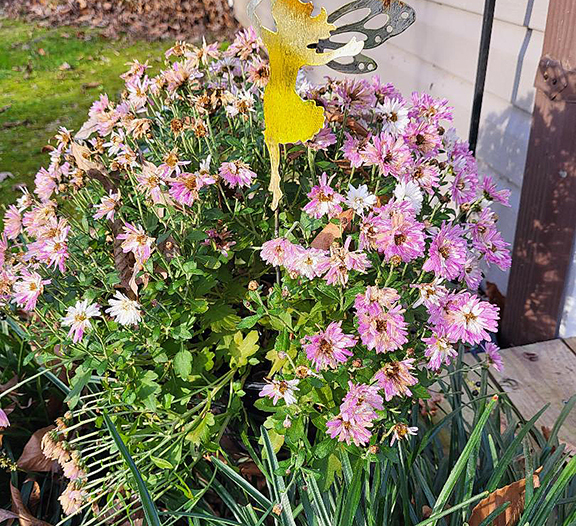Welcome!

As your fall mums begin to fade, don’t toss them! Reuse them in the flower beds or shrub borders around your home.
It's time to deal with your mums
The clock is ticking down on the mums you have had sitting on the front porch or in the living room or in your fall display. Many people are ready to move on from seasonal flower displays to seasonal light displays outside.
That doesn’t mean you should abandon the mums that did such a beautiful job of enlivening your fall season. If you have potted mums, you can easily transfer them to the landscape for lovely flowers next year — with a few caveats.
I hate to see anything go to waste in the garden. When it comes time to change out flower beds and containers, I always feel a little guilty about pulling out perfectly lovely plants. The solace I get is from telling myself, at least these faded blooms and plants will add to the compost for next year.
Fortunately, I don’t have to waste my mum displays. There’s always an empty spot to plant a few more of something.
If you have used the typical garden mum for seasonal displays, you’ll have no problem moving them to the landscape.
The name has changed over the years. We used to call them cushion mums or pot mums or hardy mums. This last was to differentiate them from florist mums. As I was browsing through some of my old gardening books, I came across another term for them that I hadn’t thought about in a long time. For a while they were marketed as azalea mums because the plants are so thoroughly covered with blooms.
Grandma used to call them October roses. I still remember the long narrow bed of mums planted between the drive to her car port and a small vegetable garden. Most of Grandma’s mums were yellow or bronze. There may have been one or two white ones in the mix. While I love all of the rainbow colors mums come in these days, bronze ones are still my favorite.
Even the Latin name has changed (as have so many over the years with advanced genetic testing and tinkering). The hardy mum is now classified as Dendrathema x grandiflora, formerly Chrysanthemum x morifolium. Nowadays, C. x morifolium covers the category of florist mum, which is an important thing to know as you plant your mums outdoors.
The typical garden mum will be happiest in a sunny spot with well-drained soil. Grandma regularly tossed aged chicken mature in her mum bed and the plants came back reliably every year. If mums have a weakness, it’s heavy soil. They can be prone to root-rot.
Not a lot of people realize that mums will bloom in the spring and fall. Their blooming cycle is triggered by short daylight hours. That’s why planting near a street light can throw the blooming cycle off.
If your mums come into bloom around April, don’t fret. Enjoy the blooms. Pinch the plant back as the blooms fade and wait for a second act around September and October.
By the way, pinching a spindly plant back during the growing season is always a good idea. Each time you do that, the plant will branch and you’ll have more flowers in the fall. Just stop pinching around the end of July to give the plant time to set blossoms.
As for florist mums, these are those gorgeous plants with the massive round flower heads that people are surrounded by on those Rose Bowl floats.
Or, you may have been gifted with a spooned mum — a flower with rays of flower petals that are tubular except right at the end where the petal opens up like a little spoon.
On spider mums, the outer petals are long, narrow and usually slightly curling.
There are several other types of florist mums like pompon mums, cactus or quill mums, anemone mums, etc.
What they all have in common is the fact that they are hardy from zones 8-10. Garden mums are hardy from zones 5-9. We’re in zone 7. You can plant florist mums outdoors in a well-drained, sunny location that is protected. Think Southern exposure near a brick wall or in a well-drained flower bed between a wall and a concrete sidewalk or drive.
They could do well, at least for a while. But if we get a particularly cold winter, your florist mums probably won’t survive.
Mums of any sort are considered tender perennials. On average, they do well for about 3-4 years. Because garden mums spread stoloniferously, you may find your mums starting to “walk” away from the spot where you set them after the third year. The center or original plant simply dies out. You can always reset the new plants.
Or you can wait until fall when you purchase more mums for your seasonal display and backfill as it comes time to set those new mums in the landscape.
